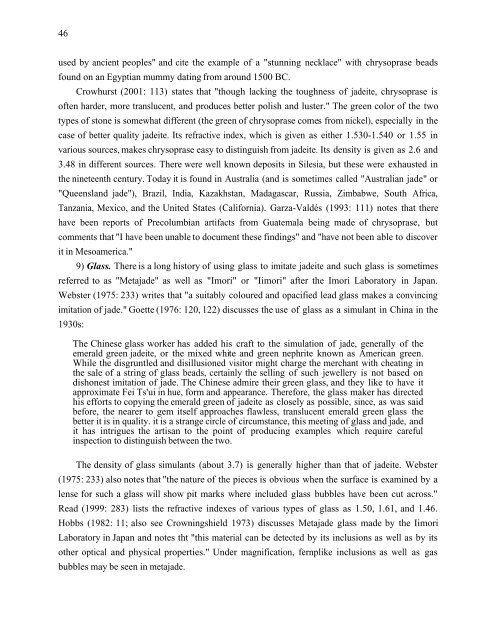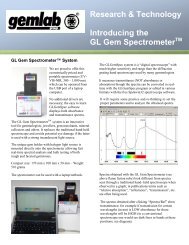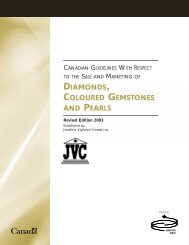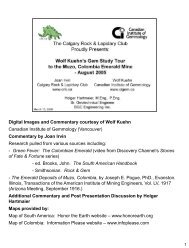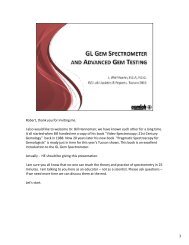JADEITE - Canadian Institute of Gemmology
JADEITE - Canadian Institute of Gemmology
JADEITE - Canadian Institute of Gemmology
Create successful ePaper yourself
Turn your PDF publications into a flip-book with our unique Google optimized e-Paper software.
46<br />
used by ancient peoples" and cite the example <strong>of</strong> a "stunning necklace" with chrysoprase beads<br />
found on an Egyptian mummy dating from around 1500 BC.<br />
Crowhurst (2001: 113) states that "though lacking the toughness <strong>of</strong> jadeite, chrysoprase is<br />
<strong>of</strong>ten harder, more translucent, and produces better polish and luster." The green color <strong>of</strong> the two<br />
types <strong>of</strong> stone is somewhat different (the green <strong>of</strong> chrysoprase comes from nickel), especially in the<br />
case <strong>of</strong> better quality jadeite. Its refractive index, which is given as either 1.530-1.540 or 1.55 in<br />
various sources, makes chrysoprase easy to distinguish from jadeite. Its density is given as 2.6 and<br />
3.48 in different sources. There were well known deposits in Silesia, but these were exhausted in<br />
the nineteenth century. Today it is found in Australia (and is sometimes called "Australian jade" or<br />
"Queensland jade"), Brazil, India, Kazakhstan, Madagascar, Russia, Zimbabwe, South Africa,<br />
Tanzania, Mexico, and the United States (California). Garza-Valdés (1993: 111) notes that there<br />
have been reports <strong>of</strong> Precolumbian artifacts from Guatemala being made <strong>of</strong> chrysoprase, but<br />
comments that "I have been unable to document these findings" and "have not been able to discover<br />
it in Mesoamerica."<br />
9) Glass. There is a long history <strong>of</strong> using glass to imitate jadeite and such glass is sometimes<br />
referred to as "Metajade" as well as "Imori" or "Iimori" after the Imori Laboratory in Japan.<br />
Webster (1975: 233) writes that "a suitably coloured and opacified lead glass makes a convincing<br />
imitation <strong>of</strong> jade." Goette (1976: 120, 122) discusses the use <strong>of</strong> glass as a simulant in China in the<br />
1930s:<br />
The Chinese glass worker has added his craft to the simulation <strong>of</strong> jade, generally <strong>of</strong> the<br />
emerald green jadeite, or the mixed white and green nephrite known as American green.<br />
While the disgruntled and disillusioned visitor might charge the merchant with cheating in<br />
the sale <strong>of</strong> a string <strong>of</strong> glass beads, certainly the selling <strong>of</strong> such jewellery is not based on<br />
dishonest imitation <strong>of</strong> jade. The Chinese admire their green glass, and they like to have it<br />
approximate Fei Ts'ui in hue, form and appearance. Therefore, the glass maker has directed<br />
his efforts to copying the emerald green <strong>of</strong> jadeite as closely as possible, since, as was said<br />
before, the nearer to gem itself approaches flawless, translucent emerald green glass the<br />
better it is in quality. it is a strange circle <strong>of</strong> circumstance, this meeting <strong>of</strong> glass and jade, and<br />
it has intrigues the artisan to the point <strong>of</strong> producing examples which require careful<br />
inspection to distinguish between the two.<br />
The density <strong>of</strong> glass simulants (about 3.7) is generally higher than that <strong>of</strong> jadeite. Webster<br />
(1975: 233) also notes that "the nature <strong>of</strong> the pieces is obvious when the surface is examined by a<br />
lense for such a glass will show pit marks where included glass bubbles have been cut across."<br />
Read (1999: 283) lists the refractive indexes <strong>of</strong> various types <strong>of</strong> glass as 1.50, 1.61, and 1.46.<br />
Hobbs (1982: 11; also see Crowningshield 1973) discusses Metajade glass made by the Iimori<br />
Laboratory in Japan and notes tht "this material can be detected by its inclusions as well as by its<br />
other optical and physical properties." Under magnification, fernplike inclusions as well as gas<br />
bubbles may be seen in metajade.


